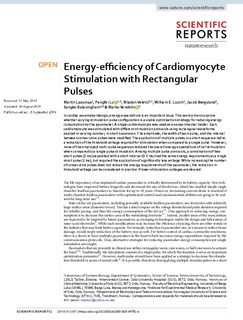| dc.contributor.author | Laasmaa, Martin | |
| dc.contributor.author | Lu, Pengfei | |
| dc.contributor.author | Veletic, Mladen | |
| dc.contributor.author | Louch, William Edward | |
| dc.contributor.author | Bergsland, Jacob | |
| dc.contributor.author | Balasingham, Ilangko | |
| dc.contributor.author | Vendelin, Marko | |
| dc.date.accessioned | 2020-01-22T11:03:18Z | |
| dc.date.available | 2020-01-22T11:03:18Z | |
| dc.date.created | 2020-01-06T11:39:09Z | |
| dc.date.issued | 2019 | |
| dc.identifier.citation | Scientific Reports. 2019, 9:13307 1-9. | nb_NO |
| dc.identifier.issn | 2045-2322 | |
| dc.identifier.uri | http://hdl.handle.net/11250/2637462 | |
| dc.description.abstract | In cardiac pacemaker design, energy expenditure is an important issue. This work aims to explore whether varying stimulation pulse configuration is a viable optimization strategy for reducing energy consumption by the pacemaker. A single cardiomyocyte was used as an experimental model. Each cardiomyocyte was stimulated with different stimulation protocols using rectangular waveforms applied in varying number, in short succession. The amplitude, the width of each pulse, and the interval between consecutive pulses were modified. The application of multiple pulses in a short sequence led to a reduction of the threshold voltage required for stimulation when compared to a single pulse. However, none of the employed multi-pulse sequences reduced the overall energy expenditure of cell stimulation when compared to a single pulse stimulation. Among multiple pulse protocols, a combination of two short pulses (1 ms) separated with a short interval (0.5 ms) had the same energy requirements as a single short pulse (1 ms), but required the application of significantly less voltage. While increasing the number of consecutive pulses does not reduce the energy requirements of the pacemaker, the reduction in threshold voltage can be considered in practice if lower stimulation voltages are desired. | nb_NO |
| dc.language.iso | eng | nb_NO |
| dc.publisher | Nature Research | nb_NO |
| dc.rights | Navngivelse 4.0 Internasjonal | * |
| dc.rights.uri | http://creativecommons.org/licenses/by/4.0/deed.no | * |
| dc.title | Energy-efficiency of Cardiomyocyte Stimulation with Rectangular Pulses | nb_NO |
| dc.type | Journal article | nb_NO |
| dc.type | Peer reviewed | nb_NO |
| dc.description.version | publishedVersion | nb_NO |
| dc.source.pagenumber | 1-9 | nb_NO |
| dc.source.volume | 9:13307 | nb_NO |
| dc.source.journal | Scientific Reports | nb_NO |
| dc.identifier.doi | 10.1038/s41598-019-49791-w | |
| dc.identifier.cristin | 1766717 | |
| dc.description.localcode | Open Access This article is licensed under a Creative Commons Attribution 4.0 International License, which permits use, sharing, adaptation, distribution and reproduction in any medium or format, as long as you give appropriate credit to the original author(s) and the source, provide a link to the Creative Commons license, and indicate if changes were made. The images or other third party material in this article are included in the article’s Creative Commons license, unless indicated otherwise in a credit line to the material. If material is not included in the article’s Creative Commons license and your intended use is not permitted by statutory regulation or exceeds the permitted use, you will need to obtain permission directly from the copyright holder. | nb_NO |
| cristin.unitcode | 194,63,35,0 | |
| cristin.unitname | Institutt for elektroniske systemer | |
| cristin.ispublished | true | |
| cristin.fulltext | original | |
| cristin.qualitycode | 1 | |

